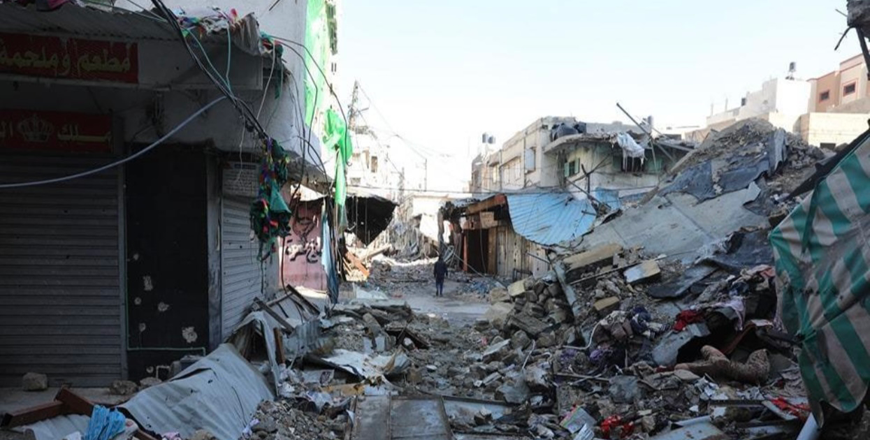You are here
Heritage Alert: Cultural devastation in Gaza’s historic market
By Sophie Constantin - May 12,2025 - Last updated at May 12,2025

View of the market near the mosque square. (Photo courtesy of Architectural Department, Islamic University, via ICOMOS Palestine)

AMMAN — Once a vibrant artery of Gaza’s Old City, Souk Al Zawiya stood as a symbol of communal life, trade, and cultural continuity. Nestled along a centuries-old trade route linking Asia and Africa, the market was not only Gaza’s largest but also one of its most historically significant.
Stretching over 250 metres, comprising 65 buildings and more than 1,150 shops, the market was a lifeline for thousands and a vital source of livelihoods for generations. Rooted in the Mamluk era and intertwined with other iconic Islamic landmarks such as the Grand Omari Mosque, Hammam Al Samra, and Qasr Al Basha, the Souk bore the architectural marks of Gaza’s layered history.
This heritage, however, now lies in rubble following sustained aerial and artillery bombardment during the Israeli military campaign that began in October 2023.
“The market attack was not just the bombing of a souk, it had deeper implications,” said Ayman Abu Shaaban, General Director of Urban Services and Geographic Information Systems (GIS) at the Municipality of Gaza, to The Jordan Times. “It was a direct strike on a cultural site that holds social and economic value and is part of Gaza’s historical and communal fabric.”
In the early days of the war, the market suffered direct strikes, leading to the widespread destruction of its structures. Israeli bombardments, which also destroyed nearby archaeological sites like the Qaisariyya Market and the Omari Mosque, revealed what experts see as a deliberate targeting of Gaza’s heritage.
Souk Al Zawiya’s destruction goes far beyond economic loss. “This market was not just a place to buy and sell, it was part of the memory and social life of Gaza’s people,” continued Abu Shaaban. “During Ramadan, holidays, and Fridays, it became a gathering place where people met and connected. Some would visit just to see familiar faces, not necessarily to shop.”
According to Shireen Allan, Director of ICOMOS Palestine, the market’s value extended well beyond its physical components: “While the market did not contain many major heritage elements, apart from some ancient shops, it was an integral part of the historic fabric of the Old City. This destruction has compromised the market’s historical and social role within the city, especially given its commercial and cultural value.”
Emergency efforts to stabilise or restore Souk Al Zawiya are currently impossible. Allan noted several critical barriers: “Ongoing airstrikes and military operations make it unsafe for restoration and recovery teams… there is limited access to materials necessary for repairs because of the blockade and ongoing genocidal war.”
Looting and vandalism further compound the devastation. “Some of the old shops, which were part of the traditional architectural style of the market, might have been looted or destroyed during the chaos following the bombings,” she added. “There is a risk of losing valuable historical fragments, including old tools, that could have had cultural and historical significance.”
The psychological and symbolic toll is equally profound. “What happened in Al Zawiya Market is a complete crime,” Allan emphasised. “Any documentation of this period must focus on the human, emotional, and symbolic side – not just material damage. The real tragedy is in the attempt to erase identity, memory, and belonging.”
Souk Al Zawiya was once Gaza’s main food market. Its ‘strategic targeting,’ coupled with the destruction of the land registry building raises fears of systemic displacement and the erasure of property rights.
“From the beginning, the first building to be bombed was the land registry, followed by central markets,” said Abu Shaaban. “The looting that followed, especially targeting food stores left behind by displaced traders, represents a deliberate attack on Gaza’s economic, social, and cultural heritage.”
This market once nourished Gaza, physically and emotionally. “Today, under these catastrophic conditions, Gaza no longer has markets like before.” As Shireen Allan warned, the true cost of this war lies not only in buildings lost, but in memory destroyed, in a heritage forcibly erased.














